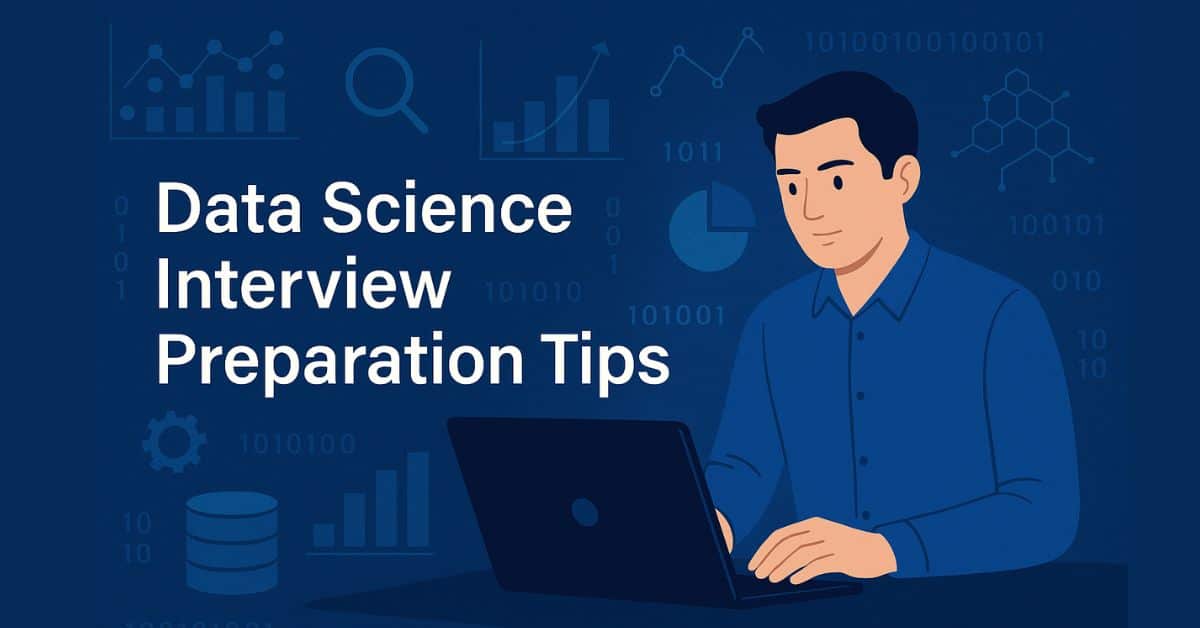Data Science continues to be one of the promising and in-demand careers for skilled professionals. A data science career is rewarding and lucrative, but the way to start a career in data science is not that simple.
A bachelor’s degree or a master’s is not required to become a data science professional. The right skill set and experience are what one needs.
This blog will help you understand the career pathways and required skills and how to start a bright career in data science.
To start a successful career in data science, you just need to have hard skill sets like analysis, machine learning, statistics, neural networks, etc. and you must be a problem solver, critical thinker, and a good storyteller to excel in data science.

New York Times considers Data Science as a “hot new field that promises to revolutionize industries from business to government, health care to academia.” However, there are a variety of different jobs and roles under the data science umbrella to choose from.
Take the data science foundations course and learn the required skills to build your data science career. Great Learning also offers various Data Science Courses and postgraduate programs that you can choose from. Learn from industry experts through online mentorship sessions and dedicated career support.
Here is a comprehensive list:
Job Roles in Data Science
- Data Analyst
- Data Engineers
- Database Administrator
- Machine Learning Engineer
- Data Scientist
- Data Architect
- Statistician
- Business Analyst
- Data and Analytics Manager
1. Data Analyst
Data analysts are responsible for a variety of tasks including visualisation, munging, and processing of massive amounts of data. They also have to perform queries on the databases from time to time.
One of the most important skills of a data analyst is optimization. This is because they have to create and modify algorithms that can be used to cull information from some of the biggest databases without corrupting the data.
Few Important Roles and Responsibilities of a Data Analyst include:
- Extracting data from primary and secondary sources using automated tools
- Developing and maintaining databases
- Performing data analysis and making reports with recommendations
- Analyzing data and forecasting trends that impact the organization/project
- Working with other team members to improve data collection and quality processes
How to Become a Data Analyst?
SQL, R, SAS, and Python are some of the sought-after technologies for data analysis. So, certification in these can easily give a boost to your job applications. You should also have good problem-solving qualities.
2. Data Engineers
Data engineers build and test scalable Big Data ecosystems for the businesses so that the data scientists can run their algorithms on the data systems that are stable and highly optimized.
Data engineers also update the existing systems with newer or upgraded versions of the current technologies to improve the efficiency of the databases.
Few Important Roles and Responsibilities of a Data Engineer include:
- Design and maintain data management systems
- Data collection/acquisition and management
- Conducting primary and secondary research
- Finding hidden patterns and forecasting trends using data
- Collaborating with other teams to perceive organizational goals
- Make reports and update stakeholders based on analytics
How to Become a Data Engineer?
If you are interested in a career as a data engineer, then technologies that require hands-on experience include Hive, NoSQL, R, Ruby, Java, C++, and Matlab. It would also help if you can work with popular data APIs and ETL tools, etc.
3. Database Administrator
The job profile of a database administrator is pretty much self-explanatory- they are responsible for the proper functioning of all the databases of an enterprise and grant or revoke its services to the employees of the company depending on their requirements. They are also responsible for database backups and recoveries.
Few Important Roles and Responsibilities of a Database Administrator include:
- Working on database software to store and manage data
- Working on database design and development
- Implementing security measures for database
- Preparing reports, documentation, and operating manuals
- Data archiving
- Working closely with programmers, project managers, and other team members
How to Become a Database Administrator?
Some of the essential skills and talents of a database administrator include database backup and recovery, data security, data modelling, and design, etc. If you are good at disaster management, it’s certainly a bonus.
4. Machine Learning Engineer
Machine learning engineers are in high demand today. However, the job profile comes with its challenges. Apart from having in-depth knowledge of some of the most powerful technologies such as SQL, REST APIs, etc.
Machine learning engineers are also expected to perform A/B testing, build data pipelines, and implement common machine learning algorithms such as classification, clustering, etc.Check out Machine learning course
Few Important Roles and Responsibilities of a Machine Learning Engineer include:
- Designing and developing Machine Learning systems
- Researching Machine Learning Algorithms
- Testing Machine Learning systems
- Developing apps/products basis client requirements
- Extending existing Machine Learning frameworks and libraries
- Exploring and visualizing data for a better understanding
- Training and retraining systems
- Know the importance of statistics in machine learning
How to Become a Machine Learning Engineer?
Firstly, you must have a sound knowledge of some of the technologies like Java, Python, JS, etc. Secondly, you should have a strong grasp of statistics and mathematics. Once you have mastered both, it’s a lot easier to crack a job interview.
5. Data Scientist
Data scientists have to understand the challenges of business and offer the best solutions using data analysis and data processing. For instance, they are expected to perform predictive analysis and run a fine-toothed comb through an “unstructured/disorganized” data to offer actionable insights.
They can also do this by identifying trends and patterns that can help the companies in making better decisions.
Few Important Roles and Responsibilities of a Data Scientist include:
- Identifying data collection sources for business needs
- Processing, cleansing, and integrating data
- Automation data collection and management process
- Using Data Science techniques/tools to improve processes
- Analyzing large amounts of data to forecast trends and provide reports with recommendations
- Collaborating with business, engineering, and product teams
How to Become a Data Scientist?
To become a data scientist, you have to be an expert in R, MatLab, SQL, Python, and other complementary technologies. It can also help if you have a higher degree in mathematics or computer engineering, etc.
6. Data Architect
A data architect creates the blueprints for data management so that the databases can be easily integrated, centralized, and protected with the best security measures. They also ensure that the data engineers have the best tools and systems to work with.
Few Important Roles and Responsibilities of a Data Architect include:
- Developing and implementing overall data strategy in line with business/organization
- Identifying data collection sources in line with data strategy
- Collaborating with cross-functional teams and stakeholders for smooth functioning of database systems
- Planning and managing end-to-end data architecture
- Maintaining database systems/architecture considering efficiency and security
- Regular auditing of data management system performance and making changes to improve systems accordingly.
How to Become a Data Architect?
A career in data architecture requires expertise in data warehousing, data modelling, extraction transformation and loan (ETL), etc. You also must be well versed in Hive, Pig, and Spark, etc.
Read Also: 15 Most Common Data Science Interview Questions
7. Statistician
A statistician, as the name suggests, has a sound understanding of statistical theories and data organization. Not only do they extract and offer valuable insights from the data clusters, but they also help create new methodologies for the engineers to apply.
Few Important Roles and Responsibilities of a Statistician include:
- Collecting, analyzing, and interpreting data
- Analyzing data, assessing results, and predicting trends/relationships using statistical methodologies/tools
- Designing data collection processes
- Communicating findings to stakeholders
- Advising/consulting on organizational and business strategy basis dat
- Coordinating with cross-functional teams
How to Become a Statistician?
A statistician has to have a passion for logic. They are also good with a variety of database systems such as SQL, data mining, and the various machine learning technologies.
8. Business Analyst
The role of business analysts is slightly different than other data science jobs. While they do have a good understanding of how data-oriented technologies work and how to handle large volumes of data, they also separate the high-value data from the low-value data.
In other words, they identify how the Big Data can be linked to actionable business insights for business growth.
Few Important Roles and Responsibilities of a Business Analyst include:
- Understanding the business of the organization
- Conducting detailed business analysis – outlining problems, opportunities, and solutions
- Working on improving existing business processes
- Analysing, designing, and implementing new technology and systems
- Budgeting and forecasting
- Pricing analysis
How to Become a Business Analyst?
Business analysts act as a link between the data engineers and the management executives. So, they should have an understanding of business finances and business intelligence, and also the IT technologies like data modelling, data visualization tools, etc.
9. Data and Analytics Manager
A data and analytics manager oversees the data science operations and assigns the duties to their team according to skills and expertise. Their strengths should include technologies like SAS, R, SQL, etc. and of course management.
Few Important Roles and Responsibilities of a Data and Analytics Manager include:
- Developing data analysis strategies
- Researching and implementing analytics solutions
- Leading and managing a team of data analysts
- Overseeing all data analytics operations to ensure quality
- Building systems and processes to transform raw data into actionable business insights
- Staying upto date on industry news and trends
How to Become a Data and Analytics Manager?
First and foremost, to go down the analytics manager career path, you must have excellent social skills, leadership qualities, and an out-of-box thinking attitude. You should also be good at data science technologies like Python, SAS, R, Java, etc.
What Next?
Data science has created a buzz all over the world. It is a stream that deals with analyzing, modeling, and generating data, and deriving meaningful insights and information from this data. The data available to us today is increasing rapidly due to the increase in digitization.
Organisations have realized the potential of data and the urgency to analyze this data to gain valuable insights from the same.
To help an organization convert this potential data into a real opportunity, organisations require skilled professionals such as data engineers, data scientists, and AI engineers.
Data scientists can mutually benefit from this since they can enhance their skills and knowledge while turning data into real-world success.
Shortage of Skilled Resources
The US will face a shortage of close to 190,000 Data Scientists and 1.5 million managers and analysts, suggests a study by McKinsey Global Institute. There is a high demand for data scientists in India too.
Technologies and tools have been introduced, but there is a gap in the number of skilled professionals available to take up these jobs and work on these tools.
The co-founder and CEO of Fractal Analytics, Srikanth Velamakanni, states that there are two types of talent deficits.
There are data scientists who do not have analytical skills or there are analysts who do not know how to appropriately use data. The demand for skilled professionals in these job roles is in high demand.
Exploiting the Power of Data
One of the main reasons why data scientists are in high demand is due to the growing potential of gathering data from the physical world. With 5G and other such networks that are coming up, digitization across all industries is growing.
5G is expanding and will also be helpful in bringing information to the supporting engineers and operators. Data that was previously available and accessible only on work PCs can now easily be streamed on the shop floor.
There are similar trends across different industries. For example, in the healthcare industry, there are more connectivity and data-collection capabilities when compared to ever before. This creates an unprecedented opportunity for Data Science to flourish.
An Impressive Pay Scale
Currently, a Data Scientist has one of the highest paying jobs in the industry. The future of Data Science is bright, and in the US, the average salary for a data scientist is US$122,525 per year according to Indeed.
The salaries vary depending on a number of factors such as job location, hiring company, work experience, and more.
Highest paying cities in the US for Data Scientists
| City | Average Salary (per year) |
| San Francisco, CA | $163,477 |
| New York, NY | $139,774 |
| Austin, TX | $131,133 |
| Los Angeles, CA | $127,028 |
| Chicago, IL | $122,438 |
| Redmond, WA | $121,827 |
| Atlanta, GA | $119,300 |
Source: Indeed
A Plethora of Job Roles
While Data Science is a broad topic under which there are several smaller and well-defined areas, there are a number of jobs that you can take up.
Some of these job roles are a data analyst, data scientist, business analyst, database administrator, and analytics manager.
There is quite a lot of difference between working in universities and educational institutions and working on real-time projects and case studies. Testing and training your machine learning models on data sets are completely different from performing any research.
The input is known as data, and the output depends on the precision and accuracy of this data. Academic research is the backbone of the applications we use on a daily basis.
However, in real-world applications and tools that are being used every day, many challenges do come up. It may be difficult to gather data.
The data may not exist, and a Data Scientist would have to work with several different database engineers to create the perfect machine learning models to be trained and tested.
Post Graduate Program in Data Science or PGP-DSA is a course offered by the McCombs School of Business at The University of Texas at Austin and delivered to you by Great Learning.
The PGP- DSBA is a top data science & analytics program and will teach you a comprehensive curriculum that covers the most widely used tools and techniques in the world of Data Science and Analytics.
The Post Graduate Program in Data Science provides a structured learning approach. You will have the opportunity to interact with industry experts, thus benefitting from their rich professional experience.
You will also work on real-time projects and case studies. The course duration is 6-months, and it will empower you to improve yourself.
PGP- DSBA also offers practice sessions with mentors, assignments, quizzes, and projects. You can add these projects to your portfolio and also share them on your social channels.
Benefits of a Data Science Career?
The demand for data science skills has skyrocketed, this is due to the numerous amounts of data that is getting generated across the businesses and the need for effective data-driven decision making.
High Salary
Work experience is the largest factor in data science salaries; however, the average salary of an entry-level data science professional is higher than the median salary in the U.S.
Solve Complex Problems
The primary job of a data science professional is to find insights by analyzing and processing a huge amount of raw data. Example: How to increase sales? To identify the hidden problems in current business operations.
Being able to extract information from data is a very powerful position to be in with data being collected in all aspects of society, ranging from marketing to health and even to sports and entertainment.”
Less Vulnerable to Job Automation
In general, the more specialized the job (fewer workers are Doing It), the less likely it is to be automated because there is less incentive to invest the resources needed to build a machine capable of the job.
At that point, data science will be an essential skill, but one not limited to a handful of experts, and we will not need anyone trained specifically in data science. I am hopeful for this time because I have repeatedly seen the importance of domain expertise for building effective data science pipelines.
If we can put the right tools in the hands of those with experience in a field, then data science can deliver on its promises of increasing efficiency and enabling objective decisions.
Automation is not likely to take data science jobs, but if the right tools are developed, a data scientist may become an extraneous specialization.
Individuals who have extensive knowledge on how to convert data into actionable insights using analytical skills are the ones who have a chance to have a bright career in data science.
Choose a Language/tool
This is probably the most asked question by beginners. Which language/ tool should I choose to excel in a career in data science?
Before answering this question, I would like to inform you that tools are just meant for implementation, but understanding the concept is more important.
The widest and simplest language used in the data science field is python, it is a user-friendly language that helps even a non-technical person to use it with ease. Let me give you a brief idea about the important languages/tools which are currently in demand.
Though Microsoft Excel can be used for data analysis, to become a data scientist you should acquire the knowledge of high-level data analysis tools. We will discuss more these tools.
Python
Python is the most widely used programming language for data science and machine learning and one of the most popular languages overall.
The python language can be used for a wide range of tasks, including data analysis, data visualization, AI, natural language processing, and robotic process automation. Developers can create web, mobile, and desktop applications in Python, too.
In addition to object-oriented programming, it supports procedural, functional, and other types, plus extensions written in C or C++.
It is used by data scientists, programmers, and network engineers and workers outside of computing disciplines, from accountants to mathematicians and scientists, who are often drawn to its user-friendly nature.
R
The R programming language is an open-source environment designed for statistical computing and graphics applications, as well as data manipulation, analysis, and visualization.
Most data scientists, academic researchers, and statisticians use R to retrieve, cleanse, analyze and present data, making it one of the most popular languages for data science and advanced analytics.
To learn more in detail, check out this R Data Science course
Data Visualization Tools
A data science professional should be a good storyteller, and he should have good knowledge of visualization tools to express their views to the audience. Let us see some of the industry’s commonly used data visualization tools.
Tableau
Tableau is a data visualization and Business Intelligence tool. This visual analytics platform is transforming the way people use data to solve problems. Tableau helps people see and understand data and make organizations more data-driven.
It is very easy to use and has become a leading choice for modern business intelligence. It helps to explore, manage, and discover insights from the data that can change businesses. It is a more powerful, secure, and flexible analytics platform.
There are various products available in tableau like Tableau desktop, server, CRM, etc. one can use as per your requirement.
Power BI
Power BI is a collection of software services, apps, and connectors that work together to turn your raw data into an interactive insight. The data might be an Excel spreadsheet or a collection of cloud-based and on-premises hybrid data warehouses.
Power BI helps you easily connect to your data sources, visualize, and discover what’s important, and share that with anyone or everyone you want. It is one of the industry’s most widely used business intelligence tools.
End Note
The data science profession is in huge demand and employers are investing significant time and money in the field. By taking the right step you can set a bright career in data science. We hope this blog would have added some value and helped you to understand how to start a bright career in data science.
Upskill in this field with Great Learning Academy’s free data science courses today!
Power BI is an essential tool in the data science industry, helping professionals transform raw data into insightful visualizations. To strengthen your skills and qualifications, you can take this Power BI free certification course, designed to enhance your data visualization capabilities.
Mastering tools like Excel is essential for many data science roles, especially when dealing with data analysis and management. If you’re looking to improve your Excel skills, check out our free online Excel course to get started with the basics.






